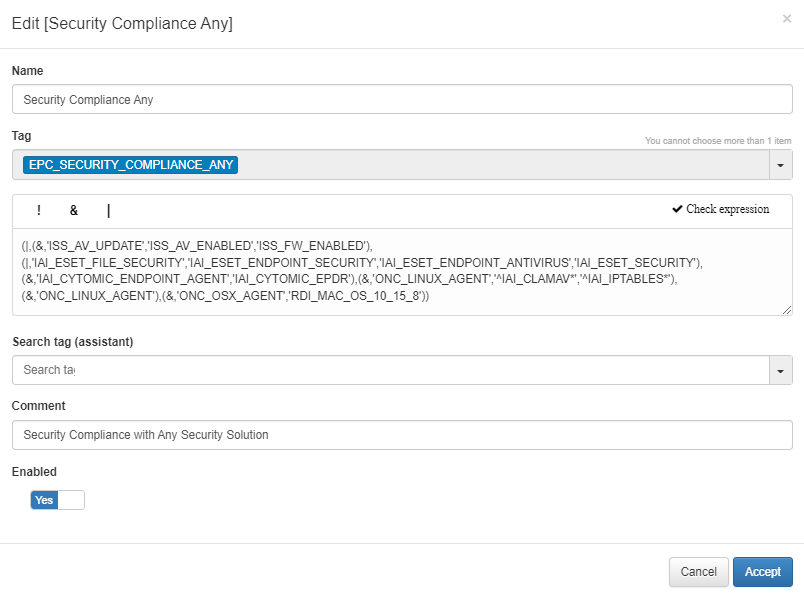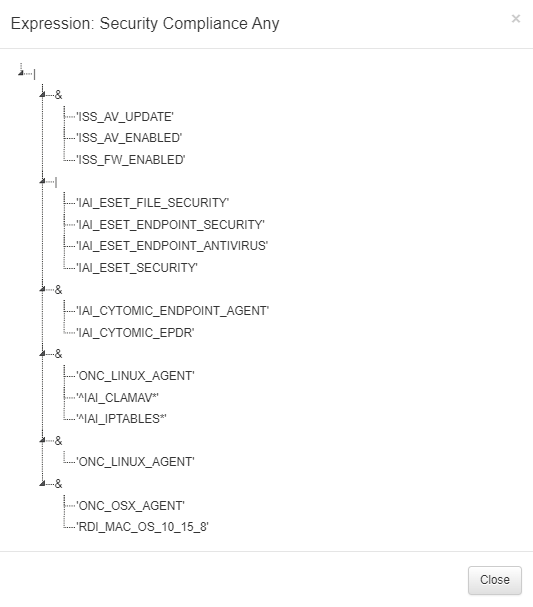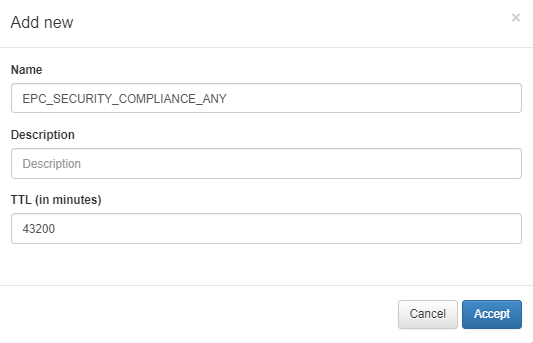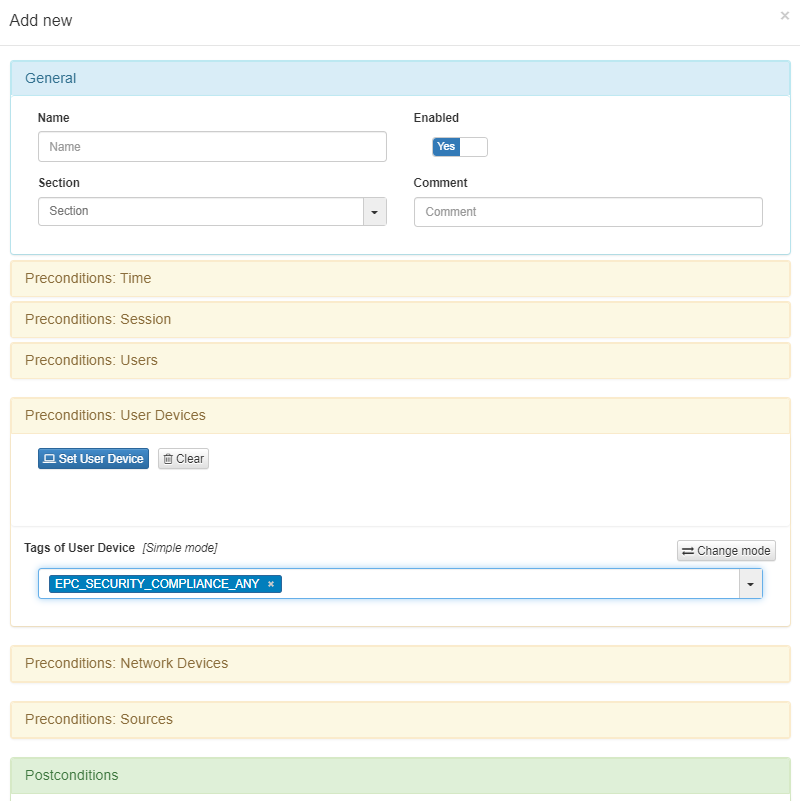4.4.1.4. Administration
This section will explain the End Point Compliance use case applied through the UD Tag Policies and the UD Tag application requirements. Both are cases applied to User Devices.
Through these two functions, we have the possibility to control the access to the network of the user devices, depending on conditions such as parameters of the device itself, elements that it has installed and activated, versions of applications installed, etc.
Important
To fulfill this use case, user devices must have the Agent installed. For information on how to install the agent, see the “Node Deployment” documentation.
The information we receive from the agent is the following:
Detailed Software Inventory
Detailed hardware inventory
Detailed Inventory of Processes
Status of security components (AV, Firewalls, etc.)
VPN integration
Others
All this information that we receive from the agent can be visualized in ON Agent -> Agent Payloads. In this window, we will be able to see the information of the payloads that we receive from the agent installed in the client. For each one of these received payloads, we will also be able to see the solution’s response in the same window.

In the Data column we can see the different blocks of information available in the Payload.
4.4.1.4.1. UD Tag Policies
We will start with the case of the UD Tag Policies. In this case, custom tags are created to use them later in the policy evaluation process.
When creating a Tag, we have two possible options:
Create it using a specific parameter of the device.
Use the device’s own Tags to create a new Tag through logical expressions.
4.4.1.4.1.1. Specific parameters
To implement this functionality, we must first select the specific parameter that we want to validate, using the information obtained by our tool. This can be useful if, for example, we wanted to check that device drivers are up to date. With this parameter, we can control if the device that connects has that specific driver updated.

The first step is to review the information obtained by the system and decide the parameter that we want to verify. To do this we go to ON CMDB -> User Devices, in this window we will see the data of all the devices registered.
In our case we are interested in filtering by parameters obtained by the agent, for this reason we click on Tags and we will have the option to filter the devices by Tags. As we are interested in those who have an agent, we filter using the ONC_AGENT tag.
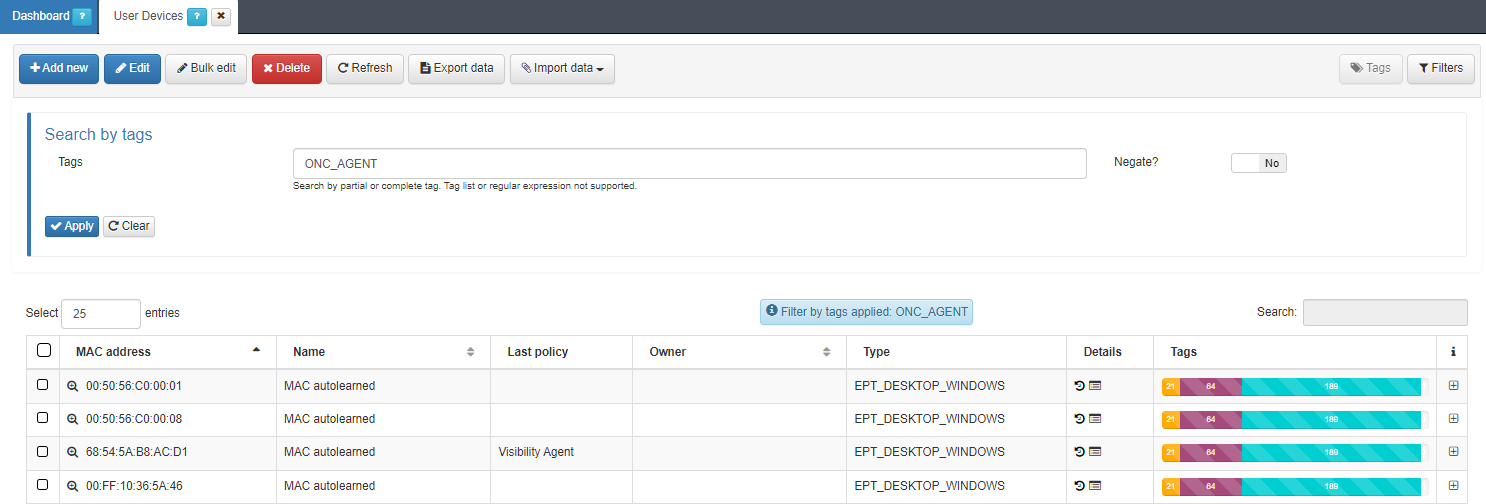
It is necessary to know the route of said parameter for the configuration of the UD Tag Policy by specific parameters. To do this, from the desired device, we click on the Inventory icon on the Details column. It will open a new window where we can see a record of the last payloads received by the user.

By clicking on the eye icon on the Data column, we can see a list with the different device parameters and their values.
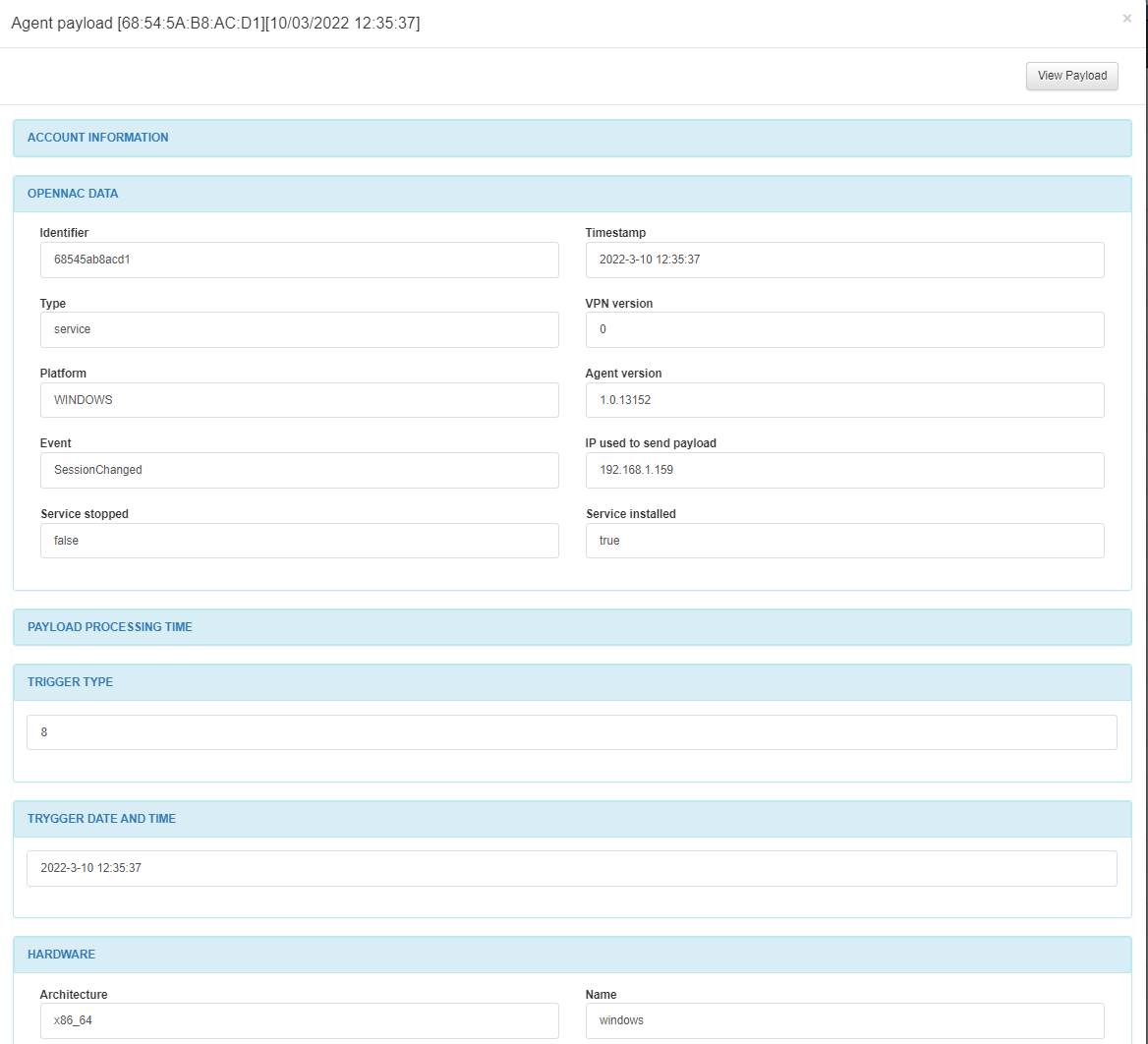
Once we have chosen the parameter we want, we access ON Agent -> Agent Configuration -> Multiplatform agent rules and click on Add new.
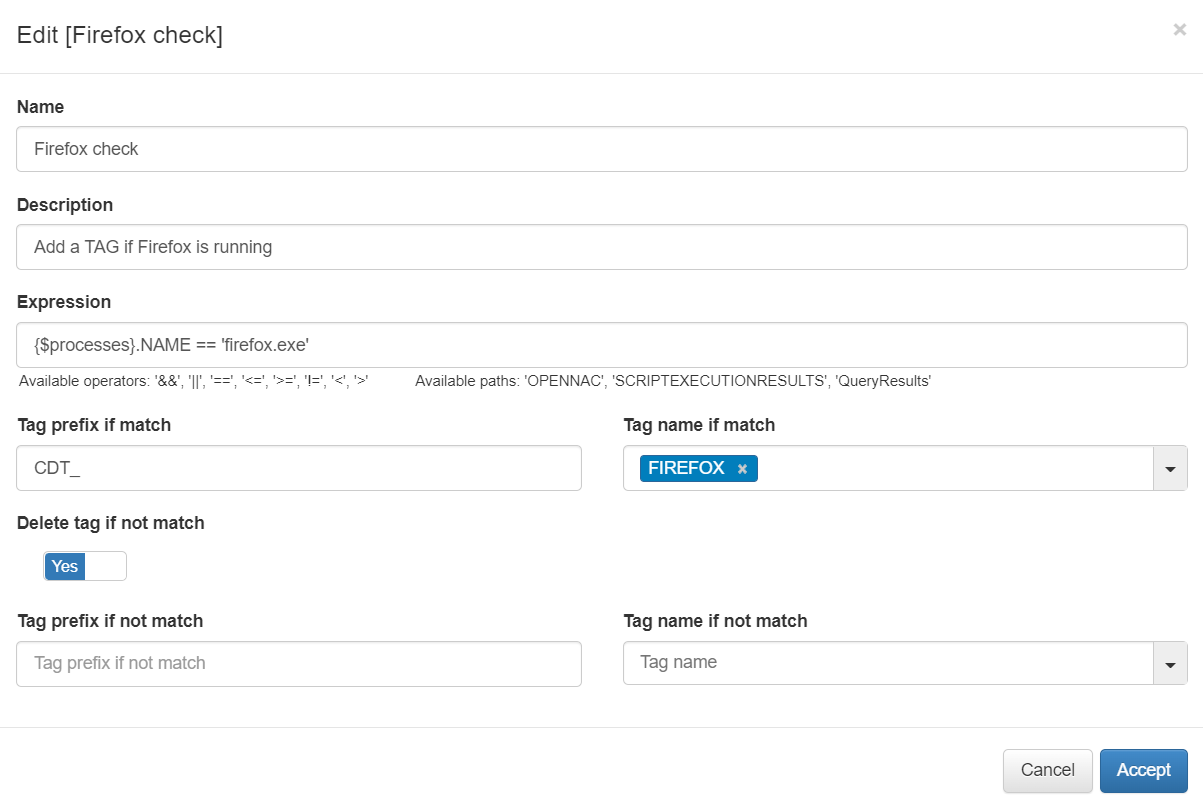
In the pop-up window we can define the Expression field, that sets the filter that matches the rule. Then we can set a tag to the user device if the rule is matched or not.
The next step is to define Tag in the database. To do this we have to go to ON CMDB -> Tags -> Tags of User Devices and click Add new.
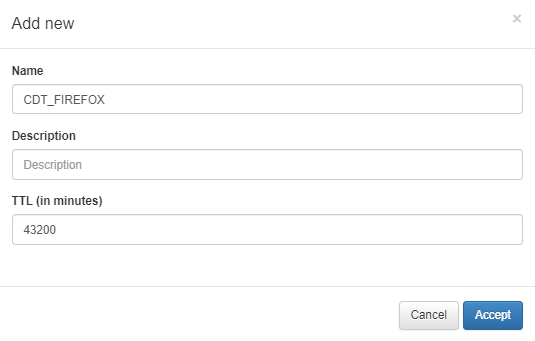
Note
If the tag is not manually added to the CMDB, when a device matches a rule when evaluating a session, it is automatically added to the CMDB.
Once the Tag is created and registered in the CMDB, we can apply the Tag to the access policies in ON NAC -> Policies at the Preconditions: User devices module:
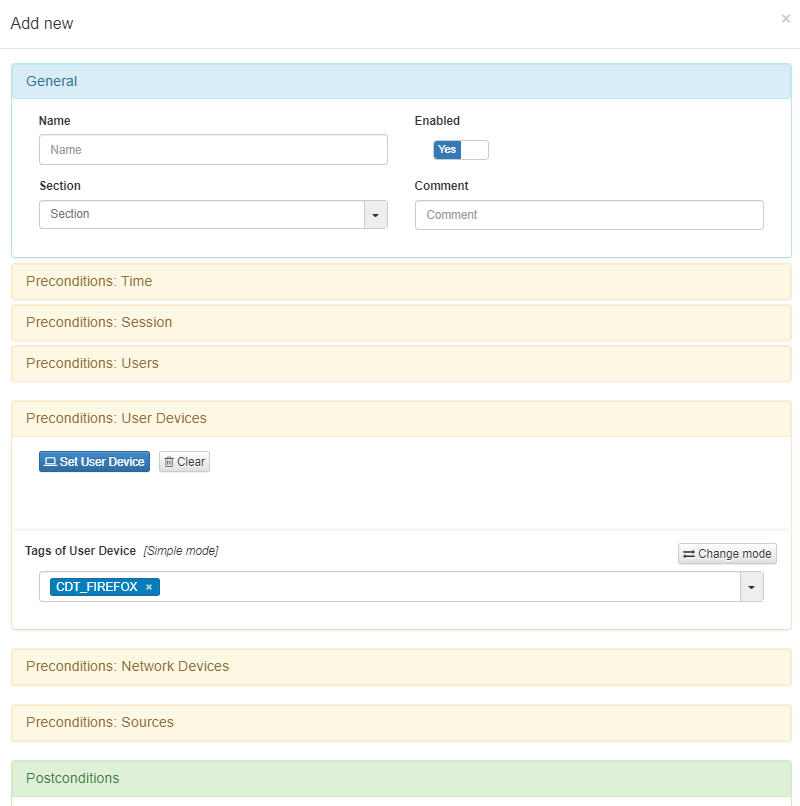
4.4.1.4.2. UD Tag application requirements
As explained at the beginning, we can also implement the compliance module using as requirements the versions of apps installed on the user device.
To do this, we need to go to ON NAC -> Tag Policies -> UD Tag application requirements and click on Add new:
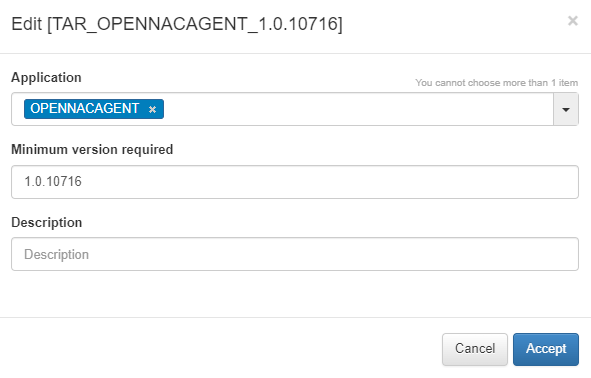
Application: Name of the application that we want to control (The same that is used in the Tags IAI_<Name Application>).
Minimum version required: The minimum version number we want for the application. Checking it is always done with the logical operator > (greater than).
Description: Description of the condition.
Once the condition has been created, we can see how the respective entry is generated, following the format TAR_<Application Name>_<version>.
When the condition is defined, in the next full payload received by the tool, in case the application does not meet the requirements, the user device will be assigned a tag with the following format NCA_APPLICATION_NAME (No Compliance Application).
4.4.1.4.3. Profiling
4.4.1.4.3.1. User device profiling
In this section, the user can create, edit, clone, delete, and simulate tags for endpoints discovered in the network. Also, administrators can import profiles from a JSON file. Based on this evaluation, OpenNAC Enterprise will insert a tag indicating the type of the device with the aspect “EPT_<device type>”
Note
When traversing this section, only continue traversing one of the hierarchies if at least one rule of the main hierarchy has been met. For example, EPT_DESKTOP_WINDOWS will be checked if at least one rule of EPT_DESKTOP is satisfied.
In addition, Parent Profile (PP<hierarchy level>_) and Parent Device Profile (PDP) tags will be added to tag different levels of the hierarchy, for example, EPT_DESKTOP_WINDOWS will create PP1_DESTKOP, PP2_DESKTOP_WINDOWS, and PDP_DESKTOP.
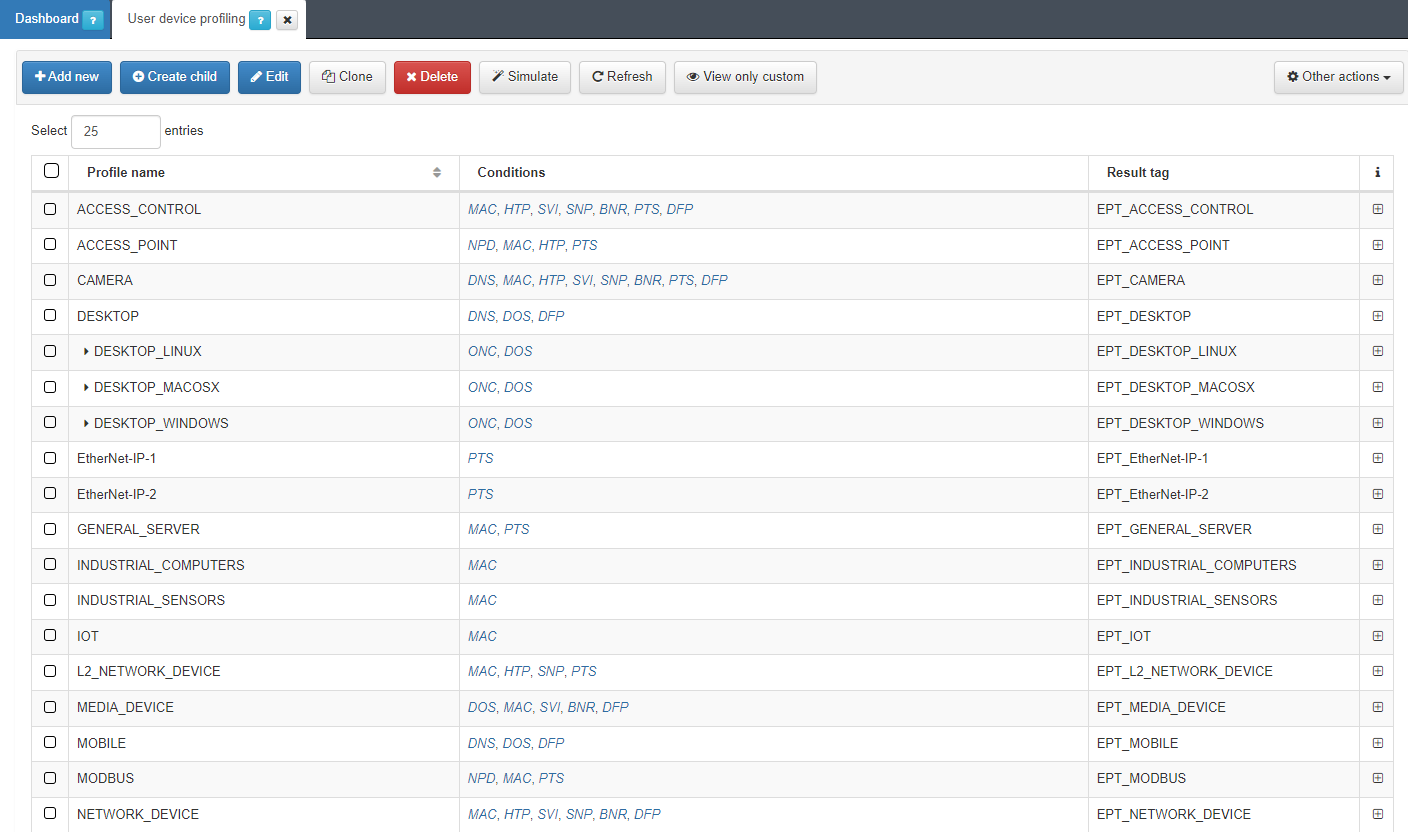
It is recommended to keep intuitive names to identify the profile’s reason. We can expand the information of each profile by clicking on the + icon:
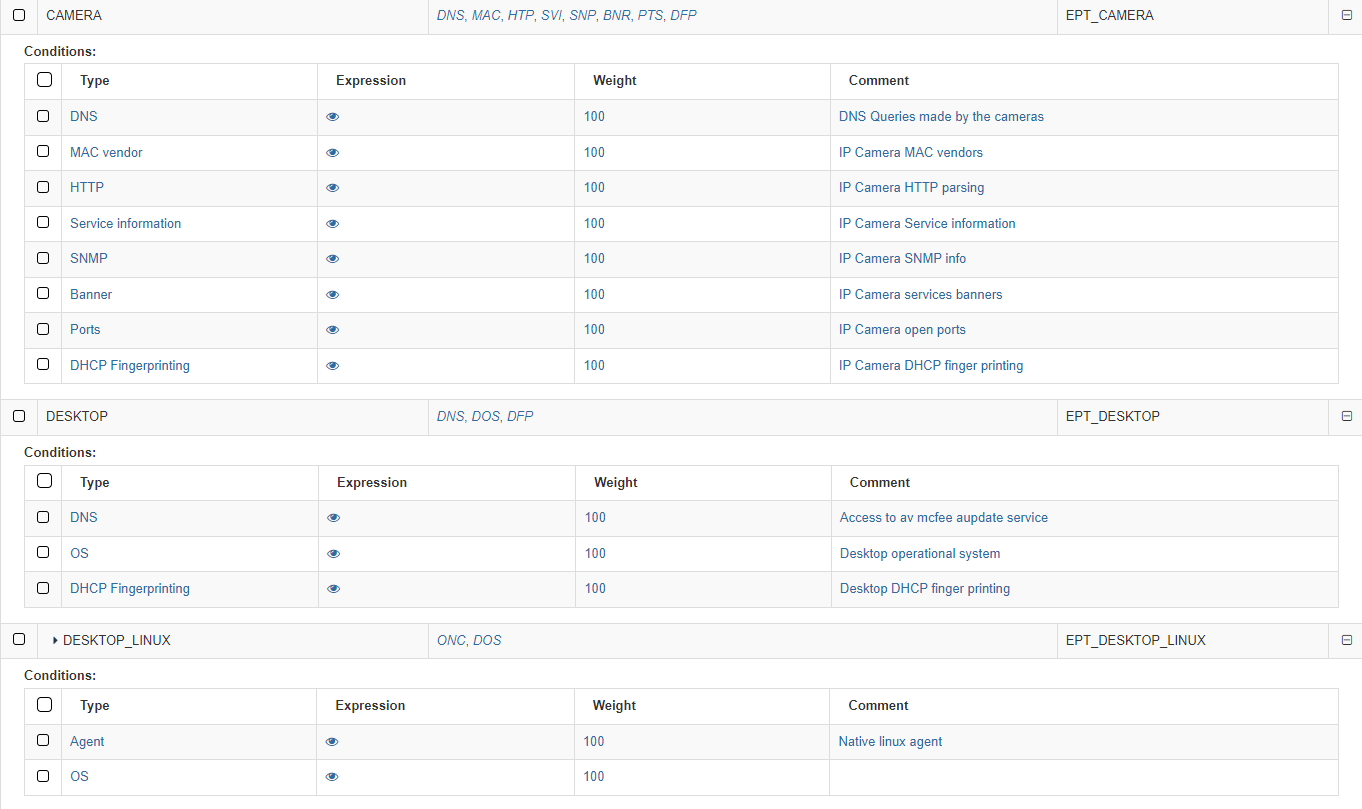
The first column on conditions shows the Type. The following list shows examples of mechanisms and methods used to identify the type of asset discovery and how it is going to be categorized:
Banner: OpenNAC Enterprise uses the banner discovered by the scanner used.
DHCP Fingerprint: OpenNAC Enterprise uses the DHCP Fingerprint capability to identify the asset type. DHCP Fingerprint is a profiling technic that allows you to identify the type of assets based on DHCP messages and its behavior.
HTTP: Information harvested by an HTTP request to the asset discovered -customized streams can be included to identify assets.
MAC Vendor: OpenNAC Enterprise can use the OUID associated with the MAC Vendor in order to discover asset typology. There may be general manufacturers (components) but in some cases, these are specific to the type of device. This system performs a weak identification since it is relatively easy to change or spoof the MAC on a device (MAC Spoofing)
Ports: OpenNAC Enterprise can use the open ports by the asset to identify the asset types.
Service Information: OpenNAC Enterprise uses the service information identified by the OpenNAC Enterprise Scanner (based on nmap), that provides the asset associated with a service.
SNMP: OpenNAC Enterprise can get and use SNMP information from the assets, additional information such as communities and OID can be used and defined.
OS: OpenNAC Enterprise uses the device operating system to get a better profiling.
Network protocol: OpenNAC Enterprise identifies the network protocol used by the device.
DNS: The DNS queries made by the device are used by OpenNAC Enterprise.
Agent: The native agent attributes allows OpenNAC Enterprise to get better profiling.
The second column Expression allows us to see the expression used by clicking on the eye icon. by the product to identify the assets types. For example an “or” (|) between some MACs:
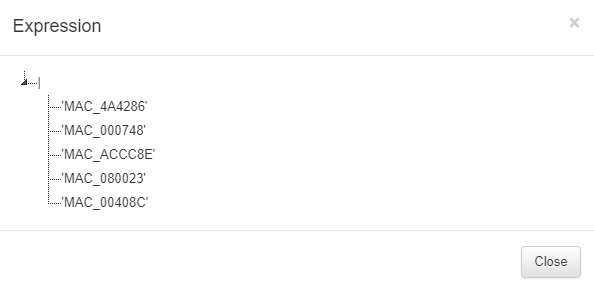
The expressions used for creating rules must be written using the following specifications:
parameters: Elements that make up the expressions (Tags).
( ): Parentheses are used to group expressions and parameters.
|: The OR character (logical operational) to indicate that any of the parameters are valid.
&: We use the AND character (logical operational) to indicate that the parameters are sums, meaning they all have to be fulfilled.
!: We use the NOT character (logical operational) to indicate that it should not contain the parameter.
,: The comma is used to indicate and separate the new parameter to analyze.
‘ ‘: Parameters are declared in quotes. For example:
Must contain all parameters = (&,’MAC_B2C7BE’,’EPC_CORPORATE_DEVICE’)
Must contain one of the parameters = (|,’MAC_B2C7BE’,’EPC_CORPORATE_DEVICE’)
Must not contain the following parameter = (!,’MAC_B2C7BE’)
The third column Weight defines a number from 0 to 100 that indicates the weight we want to apply to that condition.
The last one, Comment, shows the comments associated with the mechanism.
For each profile, we can see the tag that will associate with the device that matches the conditions.
To add a new rule, click on Add new:
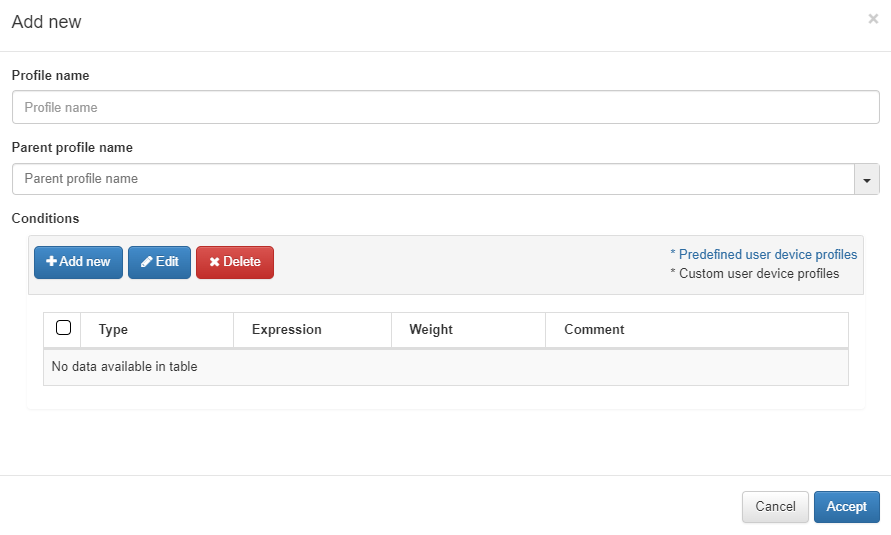
The parameters that should be configured are the following:
Profile name: Name of the profile that corresponds to the tag that will be added to the device if it matches (EPT_<profile name>). When defining the name, it is not necessary to add the EPT prefix since it will be added automatically.
Parent profile name: In the case of a “child” rule (explained below), we select the name of the parent rule that it belongs to.
Conditions: The next step will be to configure the conditions for our rule. Some of them will already be predefined, but if not, we can configure them at our convenience. If we already have one configured, we can select and edit it if not, to create a new one click on Add new and a window like the following one will open.

Type: The list with all the options that we have configured in the Column Types section. This field will indicate what type of condition it is and what it verifies.
Expression: Logical expression to be evaluated on each device. When this condition is executed within the rule, for these expressions we will use operators AND(&), OR(|), and NOT(!) and the operands will be those Tags that the devices should or should not have.
Search tag (assistant): We can use the tag search assistant to find those tags that we can use in the expressions. If we click on the found tags, they will be added automatically in the expression field.
Weight: This is the weight that this condition will have. At the time of evaluating them, if they coincide, said weight will be assigned to the overall score of the profiling rule. The greater the weight, the greater the importance of the condition.
Comment: To detail the behavior of this condition.
Enable: Flag to enable this condition.
As previously mentioned, another option is the creation of “Child” rules, which will be a subcategory of the rules that we have already created. They will help us to modify, add, or eliminate some extra parameters to that existing policy so it can accurately profile the discovered device.
Note
It is important to mention that the child rules will inherit all those conditions defined in their previously created parent rule.
To create a Child policy, select a created policy and click on Create child
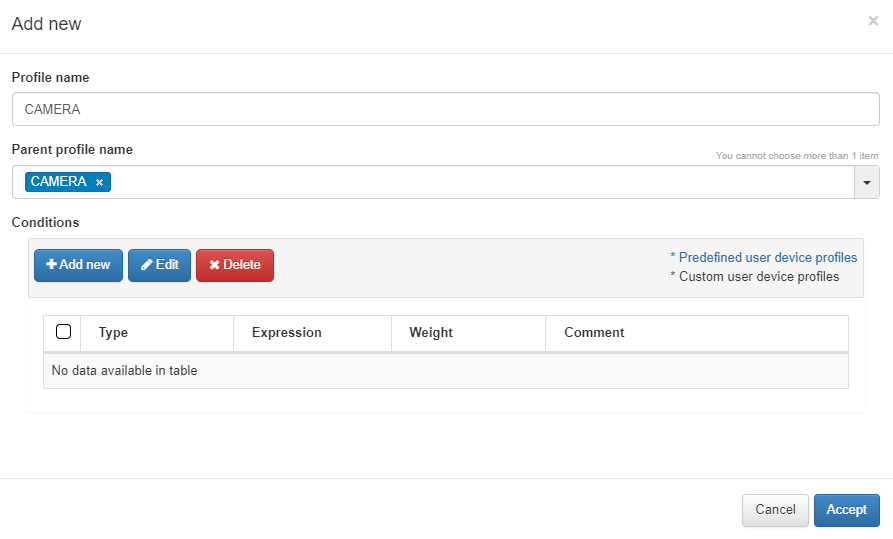
Child rules will inherit all the rules of their parent rule, but these can overwrite them to make them more specific and identify the child device.
For the conditions, we will click on Add new and configure the same parameters as when configuring a normal rule.
The user device profile allows us to create new expressions with the tag associated, in this example EPT_CAMERA. By adding a new UD tag policy, we can see the new tag with the Search tag (assistant). For more information, read ON NAC -> Tag policies -> UD Tag Policies.
Note
Administrators can perform a user device profiling simulation for any asset in OpenNAC Enterprise CMDB by right-clicking and selecting Simulate option.

4.4.1.4.3.2. Column Types
Column types define the parameter to evaluate before inserting a tag into the assets. The user can define a tag that evaluates some open ports or the MAC vendor and later based on the result insert a tag into the devices.
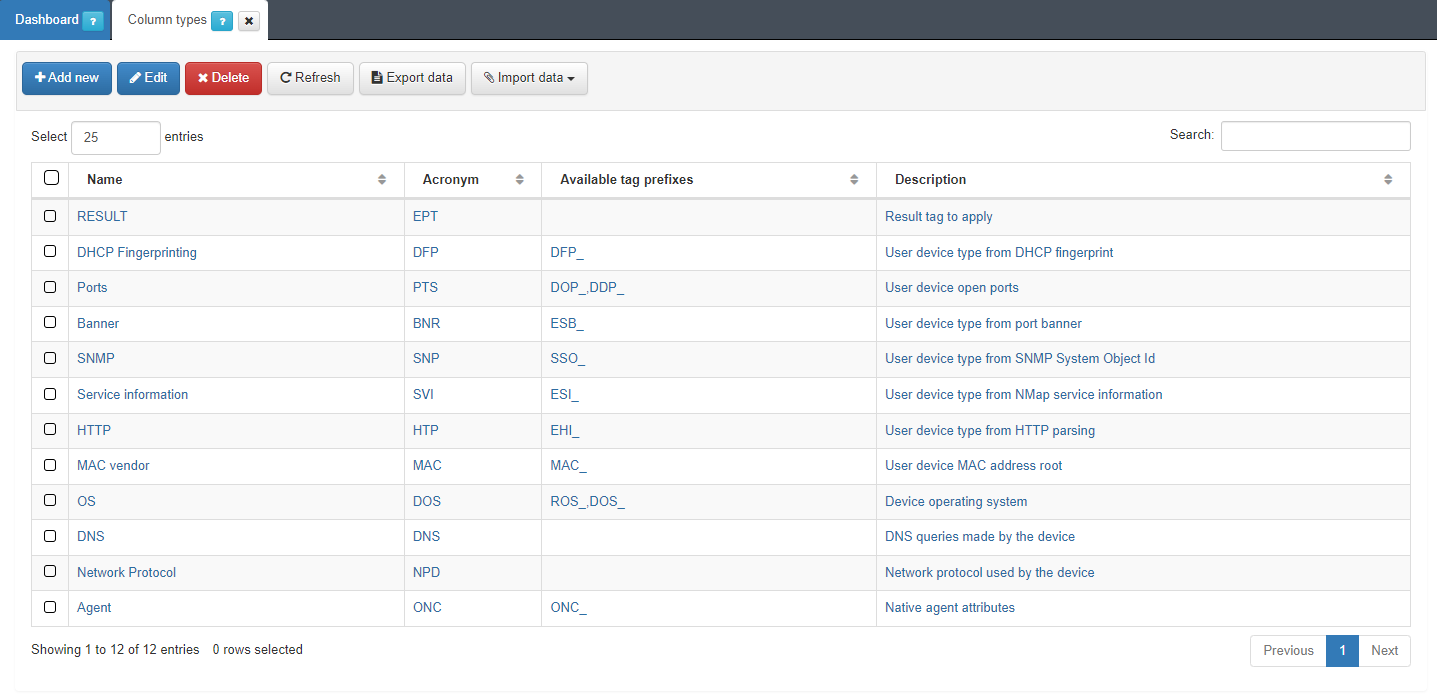
These Column Types do not add any logic to device profiling beyond the classification by condition type in the profiling rules.
To create a new parameter, click on Add new.

Name: Name of the new column type.
Acronym: Acronym used for this Column Type. It is recommended that it as descriptive as possible and refers to the name to avoid confusion. For example, DHCP fingerprint -> DFP.
Available tag prefixes: Tags related to the type that is being defined. For example, in an operating system Column type, the Tags related to this could be ROS (Root operating System) and DOS (Device Operating System). This information is purely informative and does not imply any limitation when creating the profiling rules.
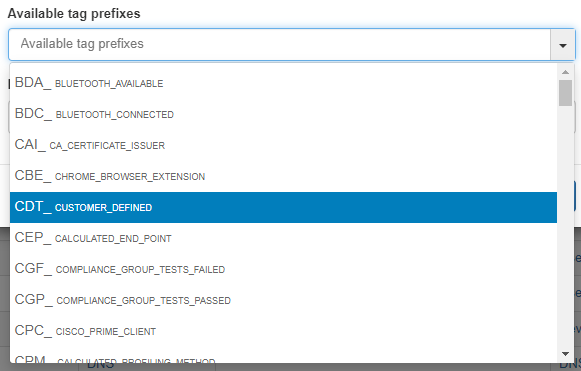
Description: description of the column type.
